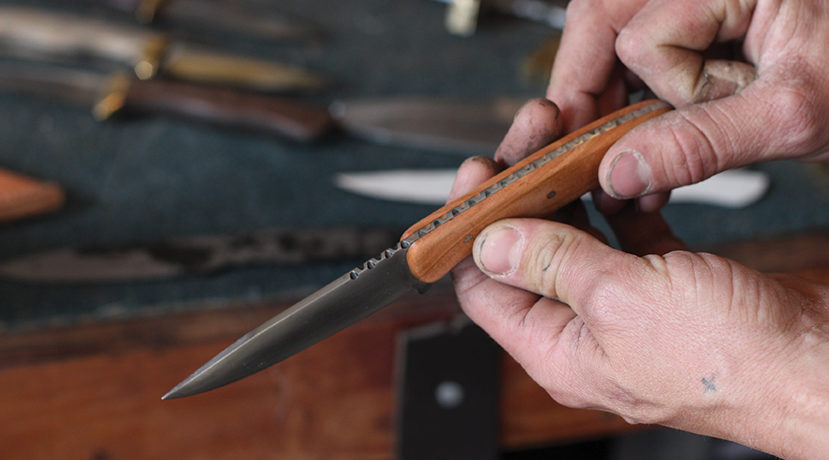It was during his time living in an inner city Chicago mission seven years ago that now-Richmonder Brent Stubblefield began making knives.
“I lived with all these old hippies and they all did stuff like leatherworking, making things with their hands, and a couple guys showed me how to make knives,” recalls Stubblefield, who-if you couldn’t tell by his well-worn hands-makes a living with them through carpentry and craftsmanship.
There is very little that he can’t make.
While he credits his time in Chicago with the roots of his seven years of knife-making, it was old-fashioned research that got his knife-smithing craft to where it is today: a dedicated shed in his South Richmond yard, where he spends hours on each of the fine blades he sells under the name “Join or Die.” His designs-the handle and blade each about the same size, branded with a series of seven ridges at the bottom of the spine-are modeled after the Finnish puukko knives, perfect for everything from fishing to hunting to snipping rope, even slicing cheese.
The process begins with the metal: 1095 high-carbon steel, a hard metal that stays sharp. “Research showed me that if you don’t get the right kind of steel, if you don’t know exactly what kind of steel you have, you’re just not going to be able to make something durable,” he says.
After using a template he designed to trace the shape of the blade onto the steel (his first knives were created by cutting shapes out of old saw blades), Stubblefield patiently uses a ban or jig saw to cut out the blade. “I burn through these cheap jigsaw blades,” he says, pointing to his stockpile of T-shanks as if they hung on a rack at the hardware store. A grinder cleans up his cuts, and then it’s over to create the bevel on the bench sander, which cuts into the steel to create the sharp edge.
“The bevel is one of the things that makes the knife what it is,” he says. “The bevel gives the knife its life; all the other things are less determinant in the character of the knife.”
Then the knife enters a small kiln for hardening (making it also as brittle as glass), moves to Stubblefield’s oven for tempering to toughen the metal, has brass soldered onto it for aesthetics and hand protection, is given a handle of wood or even deer antler (which is attached to the blade with epoxy and small decorative mosaic pins), and is polished and buffed to a shine. He’s recently started electro-etching “Join or Die Knives” onto his blades, using an etching machine that a VCU engineering friend made from a cigar box.
From hunk of steel to finely crafted final product, the whole process takes about six hours.
“In order to buy the equipment that would enable me to turn these out a lot quicker, one of these sanders is about 1,500 bucks, and if I had three that were set up with different belts, then I could rock,” he says. “So yeah, man, I might need to do that Kickstarter thing.” His kiln is also only able to harden small blades-a bigger kiln would allow him to make chef’s blades. “That’s next,” he says. People in the industrial world can use this kind of method, though many make use of a steel hardening service instead.
Stubblefield notes the name “Join or Die” is about unity and faith-nothing political about it. He thinks back to his time in Chicago when he witnessed the importance of communities supporting their people. “It impresses me how important it is to join a community,” he says. “We all have our communities around us, and the community of craftsmen and people who value that locally and handmake things in Richmond-that’s real community. It’s a real deal.”

